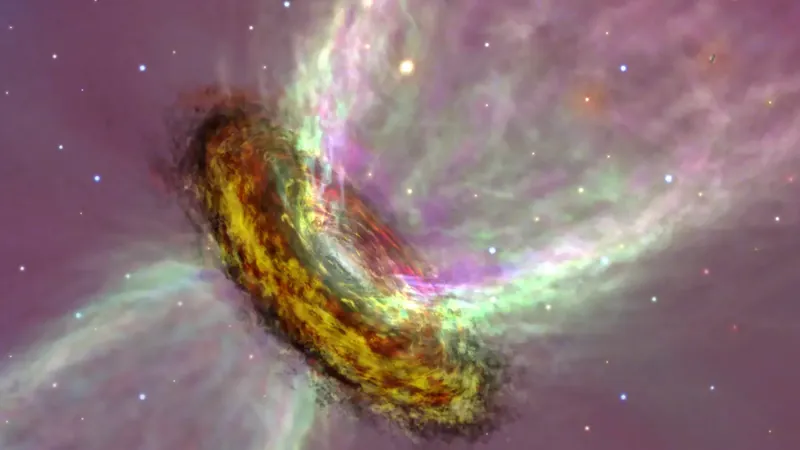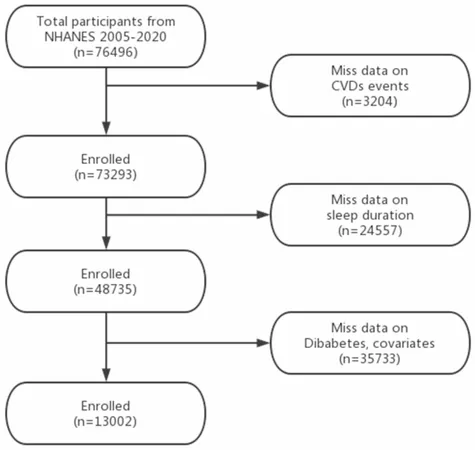
James Webb Space Telescope Unveils Stunning 'Pancake' Shaped Disks Nurturing Infant Stars and Potential Planetary Systems
2024-10-07
Author: Yu
Introduction
In a groundbreaking revelation, the James Webb Space Telescope (JWST) has provided an unprecedented glimpse into the chaotic and beautiful structures of gas and dust, affectionately dubbed "pancakes," that surround newborn stars. These protoplanetary disks are not just cosmic phenomena but are essential for the birth of stars and planets.
Observations and Findings
Recent observations made by JWST revealed detailed characteristics of the dynamic "winds of change" that sweep through these disks, shaping them and enabling young stars to collect the material necessary for their growth. This finding supports long-held theories regarding the evolutionary mechanisms of stars, emphasizing how they gather mass, which directly influences the eventual formation of planets around them.
Led by astronomers from the University of Arizona, the research team studied four edge-on protoplanetary disk systems, presenting a comprehensive view of the forces sculpting these structures. Their work offers a vivid window into our own solar system's early days approximately 4.6 billion years ago, shedding light on the conditions that existed before Earth and its neighboring planets were formed.
Team lead Ilaria Pascucci explained, “Our observations provide pioneering images of the winds that strip angular momentum away from the material in the disk, a critical factor in understanding star and planetary system formation.” She elaborated on the significance of these findings, mentioning that the way a star accrues mass plays a crucial role in the disk's evolution and the subsequent formation of surrounding planets.
Stellar Births and Angular Momentum Loss: The Science Behind the Pancakes
In an astonishing statistical fact, it is estimated that approximately 3,000 stars are born every second in the observable universe, surrounded by a cocoon of gas and dust known as a protostar. As these protostars develop, the surrounding cloud flattens and rotates, forming a disk that serves as a source of nourishment.
However, for these protostars to gather the mass needed for nuclear fusion—the process that transforms them into adult stars—the surrounding gas must lose angular momentum. If this doesn't occur, the material would continue to orbit indefinitely, unable to fall into the star. Understanding this angular momentum loss has been a significant challenge for scientists, but new insights suggest that magnetically-driven winds could explain how this loss happens, channeling gas away from the surface of the protoplanetary disk.
Tracy Beck, from NASA’s Space Telescope Science Institute, emphasized the importance of isolating the different mechanisms generating these winds. Protostars produce “X-winds” from their magnetic fields, pushing materials outward in the inner disk, whereas thermal winds generated by the protostars’ intense radiation impact the outer regions, leading to the erosion of materials.
With the JWST's advanced sensitivity and resolution in infrared observations, the team successfully differentiated between these various wind types. They utilized the instrument’s Near Infrared Spectrograph (NIRSpec) to map different atoms and molecules across the disks, creating a detailed 3D representation of the structures formed by the winds.
What Lies Ahead: Further Exploration of Protoplanetary Disks
In an exciting discovery, the researchers identified noticeable holes at the center of the cones formed by the winds in the studied disks. They plan to expand their research to include other protoplanetary disks to determine if these central holes are a common trait and to investigate the potential effects they may have on the process of feeding nascent stars.
As Pascucci optimistically stated, “While we believe these phenomena could be widespread, further observations are necessary to confirm their prevalence. Our goal is to compile a larger sample with the JWST and examine how these winds evolve as stars coalesce and planets emerge.”
With its $10 billion technology and immense capabilities, the JWST continues to unlock the mysteries of the universe, providing insights that may reshape our understanding of stellar and planetary formation, possibly altering our cosmic narrative forever. This dramatic leap forward may also lead to a deeper exploration of our solar system’s past and the infinite possibilities within the cosmos.
Conclusion
Stay tuned for more updates from the cutting-edge realm of astrological exploration!



 Brasil (PT)
Brasil (PT)
 Canada (EN)
Canada (EN)
 Chile (ES)
Chile (ES)
 España (ES)
España (ES)
 France (FR)
France (FR)
 Hong Kong (EN)
Hong Kong (EN)
 Italia (IT)
Italia (IT)
 日本 (JA)
日本 (JA)
 Magyarország (HU)
Magyarország (HU)
 Norge (NO)
Norge (NO)
 Polska (PL)
Polska (PL)
 Schweiz (DE)
Schweiz (DE)
 Singapore (EN)
Singapore (EN)
 Sverige (SV)
Sverige (SV)
 Suomi (FI)
Suomi (FI)
 Türkiye (TR)
Türkiye (TR)